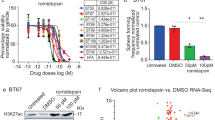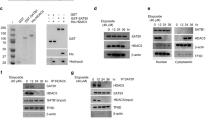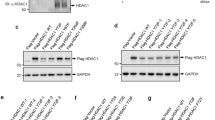Abstract
Cancer cells have complex, unique characteristics that distinguish them from normal cells, such as increased growth rates and evasion of anti-proliferative signals. Global inhibition of class I and II histone deacetylases (HDACs) stops cancer cell proliferation in vitro and has proven effective against cancer in clinical trials, at least in part, through transcriptional reactivation of the p21WAF1/Cip1gene. The HDACs that regulate p21WAF1/Cip1 are not fully identified. Using small interfering RNAs, we found that HDAC4 participates in the repression of p21WAF1/Cip1 through Sp1/Sp3-, but not p53-binding sites. HDAC4 interacts with Sp1, binds and reduces histone H3 acetylation at the Sp1/Sp3 binding site-rich p21WAF1/Cip1 proximal promoter, suggesting a key role for Sp1 in HDAC4-mediated repression of p21WAF1/Cip1. Induction of p21WAF1/Cip1 mediated by silencing of HDAC4 arrested cancer cell growth in vitro and inhibited tumor growth in an in vivo human glioblastoma model. Thus, HDAC4 could be a useful target for new anti-cancer therapies based on selective inhibition of specific HDACs.
This is a preview of subscription content, access via your institution
Access options
Subscribe to this journal
Receive 50 print issues and online access
$259.00 per year
only $5.18 per issue
Buy this article
- Purchase on Springer Link
- Instant access to full article PDF
Prices may be subject to local taxes which are calculated during checkout






Similar content being viewed by others
References
Acharya MR, Sparreboom A, Venitz J, Figg WD . (2005). Rational development of histone deacetylase inhibitors as anticancer agents: a review. Mol Pharmacol 68: 917–932.
Archer SY, Meng S, Shei A, Hodin RA . (1998). p21(WAF1) is required for butyrate-mediated growth inhibition of human colon cancer cells. Proc Natl Acad Sci USA 95: 6791–6796.
Basile V, Mantovani R, Imbriano C . (2006). DNA damage promotes histone deacetylase 4 nuclear localization and repression of G2/M promoters, via p53 C-terminal lysines. J Biol Chem 281: 2347–2357.
Bolden JE, Peart MJ, Johnstone RW . (2006). Anticancer activities of histone deacetylase inhibitors. Nat Rev Drug Discov 5: 769–784.
Davie JR . (2003). Inhibition of histone deacetylase activity by butyrate. J Nutr 133: 2485S–2493S.
de Ruijter AJ, van Gennip AH, Caron HN, Kemp S, van Kuilenburg AB . (2003). Histone deacetylases (HDACs): characterization of the classical HDAC family. Biochem J 370: 737–749.
Doetzlhofer A, Rotheneder H, Lagger G, Koranda M, Kurtev V, Brosch G et al. (1999). Histone deacetylase 1 can repress transcription by binding to Sp1. Mol Cell Biol 19: 5504–5511.
Dokmanovic M, Clarke C, Marks PA . (2007). Histone deacetylase inhibitors: overview and perspectives. Mol Cancer Res 5: 981–989.
Duvic M, Vu J . (2007a). Vorinostat in cutaneous T-cell lymphoma. Drugs Today (Barc) 43: 585–599.
Duvic M, Vu J . (2007b). Vorinostat: a new oral histone deacetylase inhibitor approved for cutaneous T-cell lymphoma. Expert Opin Investig Drugs 16: 1111–1120.
Enya K, Hayashi H, Takii T, Ohoka N, Kanata S, Okamoto T et al. (2008). The interaction with Sp1 and reduction in the activity of histone deacetylase 1 are critical for the constitutive gene expression of IL-1 alpha in human melanoma cells. J Leukoc Biol 83: 190–199.
Fang JY, Lu YY . (2002). Effects of histone acetylation and DNA methylation on p21(WAF1) regulation. World J Gastroenterol 8: 400–405.
Fischle W, Dequiedt F, Hendzel MJ, Guenther MG, Lazar MA, Voelter W et al. (2002). Enzymatic activity associated with class II HDACs is dependent on a multiprotein complex containing HDAC3 and SMRT/N-CoR. Mol Cell 9: 45–57.
Fogh J, Wright WC, Loveless JD . (1977). Absence of HeLa cell contamination in 169 cell lines derived from human tumors. J Natl Cancer Inst 58: 209–214.
Geng L, Cuneo KC, Fu A, Tu T, Atadja PW, Hallahan DE . (2006). Histone deacetylase (HDAC) inhibitor LBH589 increases duration of gamma-H2AX foci and confines HDAC4 to the cytoplasm in irradiated non-small cell lung cancer. Cancer Res 66: 11298–11304.
Glenisson W, Castronovo V, Waltregny D . (2007). Histone deacetylase 4 is required for TGFbeta1-induced myofibroblastic differentiation. Biochim Biophys Acta 1773: 1572–1582.
Glozak MA, Sengupta N, Zhang X, Seto E . (2005). Acetylation and deacetylation of non-histone proteins. Gene 363: 15–23.
Grozinger CM, Schreiber SL . (2000). Regulation of histone deacetylase 4 and 5 and transcriptional activity by 14-3-3-dependent cellular localization. Proc Natl Acad Sci USA 97: 7835–7840.
Hagedorn M, Javerzat S, Gilges D, Meyre A, de Lafarge B, Eichmann A et al. (2005). Accessing key steps of human tumor progression in vivo by using an avian embryo model. Proc Natl Acad Sci USA 102: 1643–1648.
Halkidou K, Cook S, Leung HY, Neal DE, Robson CN . (2004). Nuclear accumulation of histone deacetylase 4 (HDAC4) coincides with the loss of androgen sensitivity in hormone refractory cancer of the prostate. Eur Urol 45: 382–389; author reply 389.
Han JW, Ahn SH, Kim YK, Bae GU, Yoon JW, Hong S et al. (2001). Activation of p21(WAF1/Cip1) transcription through Sp1 sites by histone deacetylase inhibitor apicidin: involvement of protein kinase C. J Biol Chem 276: 42084–42090.
Han JW, Ahn SH, Park SH, Wang SY, Bae GU, Seo DW et al. (2000). Apicidin, a histone deacetylase inhibitor, inhibits proliferation of tumor cells via induction of p21WAF1/Cip1 and gelsolin. Cancer Res 60: 6068–6074.
He S, Sun JM, Li L, Davie JR . (2005). Differential intranuclear organization of transcription factors Sp1 and Sp3. Mol Biol Cell 16: 4073–4083.
Hildmann C, Riester D, Schwienhorst A . (2007). Histone deacetylases--an important class of cellular regulators with a variety of functions. Appl Microbiol Biotechnol 75: 487–497.
Huang BH, Laban M, Leung CH, Lee L, Lee CK, Salto-Tellez M et al. (2005). Inhibition of histone deacetylase 2 increases apoptosis and p21Cip1/WAF1 expression, independent of histone deacetylase 1. Cell Death Differ 12: 395–404.
Huang EY, Zhang J, Miska EA, Guenther MG, Kouzarides T, Lazar MA . (2000). Nuclear receptor corepressors partner with class II histone deacetylases in a Sin3-independent repression pathway. Genes Dev 14: 45–54.
Huang L, Pardee AB . (2000). Suberoylanilide hydroxamic acid as a potential therapeutic agent for human breast cancer treatment. Mol Med 6: 849–866.
Huang W, Tan D, Wang X, Han S, Tan J, Zhao Y et al. (2006). Histone deacetylase 3 represses p15(INK4b) and p21(WAF1/cip1) transcription by interacting with Sp1. Biochem Biophys Res Commun 339: 165–171.
Imbriano C, Gurtner A, Cocchiarella F, Di Agostino S, Basile V, Gostissa M et al. (2005). Direct p53 transcriptional repression: in vivo analysis of CCAAT-containing G2/M promoters. Mol Cell Biol 25: 3737–3751.
Kang JE, Kim MH, Lee JA, Park H, Min-Nyung L, Auh CK et al. (2005). Histone deacetylase-1 represses transcription by interacting with zinc-fingers and interfering with the DNA binding activity of Sp1. Cell Physiol Biochem 16: 23–30.
Kao GD, McKenna WG, Guenther MG, Muschel RJ, Lazar MA, Yen TJ . (2003). Histone deacetylase 4 interacts with 53BP1 to mediate the DNA damage response. J Cell Biol 160: 1017–1027.
Kao HY, Downes M, Ordentlich P, Evans RM . (2000). Isolation of a novel histone deacetylase reveals that class I and class II deacetylases promote SMRT-mediated repression. Genes Dev 14: 55–66.
Kelly WK, Marks PA . (2005). Drug insight: histone deacetylase inhibitors--development of the new targeted anticancer agent suberoylanilide hydroxamic acid. Nat Clin Pract Oncol 2: 150–157.
Khochbin S, Verdel A, Lemercier C, Seigneurin-Berny D . (2001). Functional significance of histone deacetylase diversity. Curr Opin Genet Dev 11: 162–166.
Kim YB, Lee KH, Sugita K, Yoshida M, Horinouchi S . (1999). Oxamflatin is a novel antitumor compound that inhibits mammalian histone deacetylase. Oncogene 18: 2461–2470.
Labarca C, Paigen K . (1980). A simple, rapid, and sensitive DNA assay procedure. Anal Biochem 102: 344–352.
Lagger G, Doetzlhofer A, Schuettengruber B, Haidweger E, Simboeck E, Tischler J et al. (2003). The tumor suppressor p53 and histone deacetylase 1 are antagonistic regulators of the cyclin-dependent kinase inhibitor p21/WAF1/CIP1 gene. Mol Cell Biol 23: 2669–2679.
Lagger G, O’Carroll D, Rembold M, Khier H, Tischler J, Weitzer G et al. (2002). Essential function of histone deacetylase 1 in proliferation control and CDK inhibitor repression. EMBO J 21: 2672–2681.
Lavrrar JL, Farnham PJ . (2004). The use of transient chromatin immunoprecipitation assays to test models for E2F1-specific transcriptional activation. J Biol Chem 279: 46343–46349.
Lemercier C, Brocard MP, Puvion-Dutilleul F, Kao HY, Albagli O, Khochbin S . (2002). Class II histone deacetylases are directly recruited by BCL6 transcriptional repressor. J Biol Chem 277: 22045–22052.
LLeonart ME, Vidal F, Gallardo D, Diaz-Fuertes M, Rojo F, Cuatrecasas M et al. (2006). New p53 related genes in human tumors: significant downregulation in colon and lung carcinomas. Oncol Rep 16: 603–608.
Luo J, Li M, Tang Y, Laszkowska M, Roeder RG, Gu W . (2004). Acetylation of p53 augments its site-specific DNA binding both in vitro and in vivo. Proc Natl Acad Sci USA 101: 2259–2264.
Marks PA, Richon VM, Kelly WK, Chiao JH, Miller T . (2004). Histone deacetylase inhibitors: development as cancer therapy. Novartis Found Symp 259: 269–281; discussion 281–288.
Martin-Caballero J, Flores JM, Garcia-Palencia P, Serrano M . (2001). Tumor susceptibility of p21(Waf1/Cip1)-deficient mice. Cancer Res 61: 6234–6238.
McLaughlin F, La Thangue NB . (2004). Histone deacetylase inhibitors open new doors in cancer therapy. Biochem Pharmacol 68: 1139–1144.
Minucci S, Pelicci PG . (2006). Histone deacetylase inhibitors and the promise of epigenetic (and more) treatments for cancer. Nat Rev Cancer 6: 38–51.
Mottet D, Bellahcene A, Pirotte S, Waltregny D, Deroanne C, Lamour V et al. (2007). HDAC7 silencing alters endothelial cell migration, a key step in angiogenesis. Circ Res 101: 1237–1246.
Nakano K, Mizuno T, Sowa Y, Orita T, Yoshino T, Okuyama Y et al. (1997). Butyrate activates the WAF1/Cip1 gene promoter through Sp1 sites in a p53-negative human colon cancer cell line. J Biol Chem 272: 22199–22206.
Philipp J, Vo K, Gurley KE, Seidel K, Kemp CJ . (1999). Tumor suppression by p27Kip1 and p21Cip1 during chemically induced skin carcinogenesis. Oncogene 18: 4689–4698.
Poole AJ, Heap D, Carroll RE, Tyner AL . (2004). Tumor suppressor functions for the Cdk inhibitor p21 in the mouse colon. Oncogene 23: 8128–8134.
Rasheed WK, Johnstone RW, Prince HM . (2007). Histone deacetylase inhibitors in cancer therapy. Expert Opin Investig Drugs 16: 659–678.
Richon VM, Sandhoff TW, Rifkind RA, Marks PA . (2000). Histone deacetylase inhibitor selectively induces p21WAF1 expression and gene-associated histone acetylation. Proc Natl Acad Sci USA 97: 10014–10019.
Rocchi P, Tonelli R, Camerin C, Purgato S, Fronza R, Bianucci F et al. (2005). p21Waf1/Cip1 is a common target induced by short-chain fatty acid HDAC inhibitors (valproic acid, tributyrin and sodium butyrate) in neuroblastoma cells. Oncol Rep 13: 1139–1144.
Roy S, Packman K, Jeffrey R, Tenniswood M . (2005). Histone deacetylase inhibitors differentially stabilize acetylated p53 and induce cell cycle arrest or apoptosis in prostate cancer cells. Cell Death Differ 12: 482–491.
Saito A, Yamashita T, Mariko Y, Nosaka Y, Tsuchiya K, Ando T et al. (1999). A synthetic inhibitor of histone deacetylase, MS-27-275, with marked in vivo antitumor activity against human tumors. Proc Natl Acad Sci USA 96: 4592–4597.
Sambucetti LC, Fischer DD, Zabludoff S, Kwon PO, Chamberlin H, Trogani N et al. (1999). Histone deacetylase inhibition selectively alters the activity and expression of cell cycle proteins leading to specific chromatin acetylation and antiproliferative effects. J Biol Chem 274: 34940–34947.
Sawa H, Murakami H, Kumagai M, Nakasato M, Yamauchi S, Matsuyama N et al. (2004). Histone deacetylase inhibitor, FK228, induces apoptosis and suppresses cell proliferation of human glioblastoma cells in vitro and in vivo. Acta Neuropathol (Berl) 107: 523–531.
Senese S, Zaragoza K, Minardi S, Muradore I, Ronzoni S, Passafaro A et al. (2007). Role for histone deacetylase 1 in human tumor cell proliferation. Mol Cell Biol 27: 4784–4795.
Sowa Y, Orita T, Minamikawa-Hiranabe S, Mizuno T, Nomura H, Sakai T . (1999). Sp3, but not Sp1, mediates the transcriptional activation of the p21/WAF1/Cip1 gene promoter by histone deacetylase inhibitor. Cancer Res 59: 4266–4270.
Sowa Y, Orita T, Minamikawa S, Nakano K, Mizuno T, Nomura H et al. (1997). Histone deacetylase inhibitor activates the WAF1/Cip1 gene promoter through the Sp1 sites. Biochem Biophys Res Commun 241: 142–150.
Spurling CC, Godman CA, Noonan EJ, Rasmussen TP, Rosenberg DW, Giardina C . (2008). HDAC3 overexpression and colon cancer cell proliferation and differentiation. Mol Carcinog 47: 137–147.
Sun JM, Chen HY, Moniwa M, Litchfield DW, Seto E, Davie JR . (2002). The transcriptional repressor Sp3 is associated with CK2-phosphorylated histone deacetylase 2. J Biol Chem 277: 35783–35786.
Tang HY, Zhao K, Pizzolato JF, Fonarev M, Langer JC, Manfredi JJ . (1998). Constitutive expression of the cyclin-dependent kinase inhibitor p21 is transcriptionally regulated by the tumor suppressor protein p53. J Biol Chem 273: 29156–29163.
Topley GI, Okuyama R, Gonzales JG, Conti C, Dotto GP . (1999). p21(WAF1/Cip1) functions as a suppressor of malignant skin tumor formation and a determinant of keratinocyte stem-cell potential. Proc Natl Acad Sci USA 96: 9089–9094.
Urban G, Golden T, Aragon IV, Cowsert L, Cooper SR, Dean NM et al. (2003). Identification of a functional link for the p53 tumor suppressor protein in dexamethasone-induced growth suppression. J Biol Chem 278: 9747–9753.
Waltregny D, Glenisson W, Tran SL, North BJ, Verdin E, Colige A et al. (2005). Histone deacetylase HDAC8 associates with smooth muscle alpha-actin and is essential for smooth muscle cell contractility. FASEB J 19: 966–968.
Wilson AJ, Byun DS, Nasser S, Murray L, Ayyanar K, Arango D et al. (2008). HDAC4 promotes growth of colon cancer cells via repression of p21. Mol Biol Cell.
Wilson AJ, Byun DS, Popova N, Murray LB, L’Italien K, Sowa Y et al. (2006). Histone deacetylase 3 (HDAC3) and other class I HDACs regulate colon cell maturation and p21 expression and are deregulated in human colon cancer. J Biol Chem 281: 13548–13558.
Wouters BG, Giaccia AJ, Denko NC, Brown JM . (1997). Loss of p21Waf1/Cip1 sensitizes tumors to radiation by an apoptosis-independent mechanism. Cancer Res 57: 4703–4706.
Xiong Y, Hannon GJ, Zhang H, Casso D, Kobayashi R, Beach D . (1993). p21 is a universal inhibitor of cyclin kinases. Nature 366: 701–704.
Xu WS, Parmigiani RB, Marks PA . (2007). Histone deacetylase inhibitors: molecular mechanisms of action. Oncogene 26: 5541–5552.
Yang XJ, Seto E . (2008). The Rpd3/Hda1 family of lysine deacetylases: from bacteria and yeast to mice and men. Nat Rev Mol Cell Biol 9: 206–218.
Zhao Y, Lu S, Wu L, Chai G, Wang H, Chen Y et al. (2006). Acetylation of p53 at lysine 373/382 by the histone deacetylase inhibitor depsipeptide induces expression of p21(Waf1/Cip1). Mol Cell Biol 26: 2782–2790.
Acknowledgements
This work was supported by grants from European FP6 (STROMA and METABRE), the National Fund for Scientific Research (Belgium), the Centre Anti-Cancéreux près de l’Université de Liège, the Fonds Léon Frédéricq, TELEVIE and Interuniversity Attraction Pole Program–Belgian Science Policy (IAP 5/31). DM and AB are Research Associates at the National Fund for Scientific Research (Belgium). VL and SP are NFSR National Fund for Scientific Research fellows.
Author information
Authors and Affiliations
Corresponding authors
Additional information
Supplementary Information accompanies the paper on the Oncogene website (http://www.nature.com/onc)
Rights and permissions
About this article
Cite this article
Mottet, D., Pirotte, S., Lamour, V. et al. HDAC4 represses p21WAF1/Cip1 expression in human cancer cells through a Sp1-dependent, p53-independent mechanism. Oncogene 28, 243–256 (2009). https://doi.org/10.1038/onc.2008.371
Received:
Revised:
Accepted:
Published:
Issue Date:
DOI: https://doi.org/10.1038/onc.2008.371
Keywords
This article is cited by
-
microRNA-124-3p attenuates myocardial injury in sepsis via modulating SP1/HDAC4/HIF-1α axis
Cell Death Discovery (2022)
-
Multi-omics data integration reveals novel drug targets in hepatocellular carcinoma
BMC Genomics (2021)
-
Conditional deletion of HDAC4 from collagen type 2α1-expressing cells increases angiogenesis in vivo
Molecular Medicine (2020)
-
Molecular imaging HDACs class IIa expression-activity and pharmacologic inhibition in intracerebral glioma models in rats using PET/CT/(MRI) with [18F]TFAHA
Scientific Reports (2019)
-
A dual role of miR-22 modulated by RelA/p65 in resensitizing fulvestrant-resistant breast cancer cells to fulvestrant by targeting FOXP1 and HDAC4 and constitutive acetylation of p53 at Lys382
Oncogenesis (2018)



